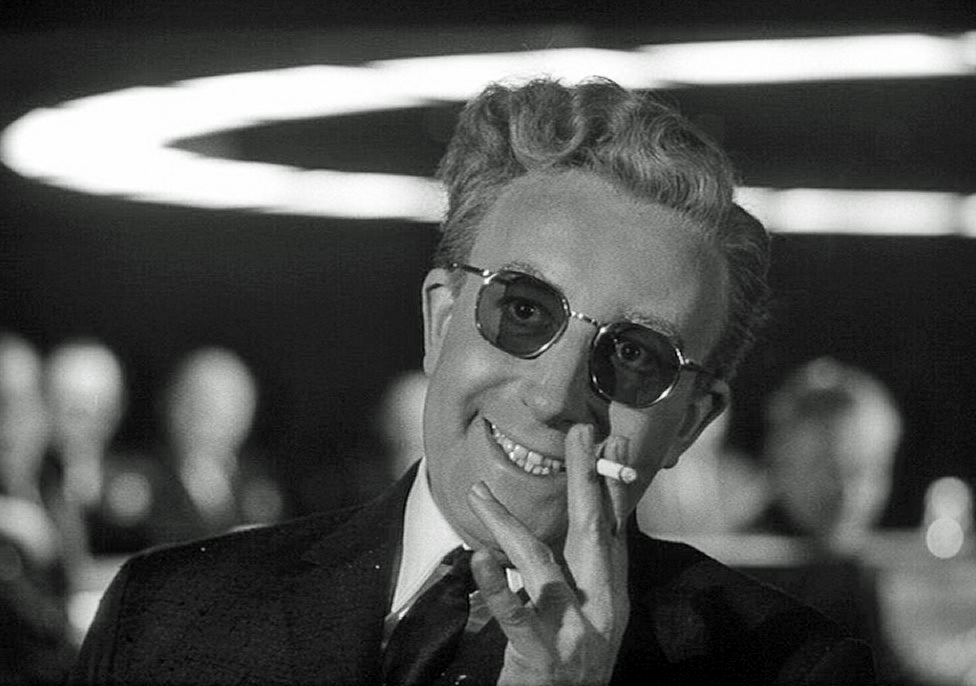NOTES FROM UNDERGROUND
Hope
Links
- Get link
- X
- Other Apps
Dr. Strangelove (1964)
Seen after 30 years, "Dr. Strangelove" seems remarkably fresh and undated - a clear-eyed, irreverant, dangerous satire. And its willingness to follow the situation to its logical conclusion - nuclear annihilation - has a purity that today's lily-livered happy-ending technicians would probably find a way around. Its black and white photography helps, too, putting an unadorned face on its deadly political paradoxes. If movies of this irreverence, intelligence and savagery were still being made, the world would seem a younger place.
Every time you see a great film, you find new things in it. Viewing Stanley Kubrick's "Dr. Strangelove" for perhaps the 10th time, I discovered what George C. Scott does with his face. His performance is the funniest thing in the movie--better even than the inspired triple performance by Peter Sellers or the nutjob general played by Sterling Hayden--but this time I found myself paying special attention to the tics and twitches, the grimaces and eyebrow archings, the sardonic smiles and gum-chewing, and I enjoyed the way Scott approached the role as a duet for voice and facial expression.
In the days after it first opened in early 1964, Stanley Kubrick's "Dr. Strangelove" took on the enchanted aura of a film that had gotten away with something. Johnson was in the White House, the Republicans were grooming Goldwater, both sides took the Cold War with grim solemnity, and the world was learning to be comfortable with the term "nuclear deterrent," which meant that if you blow me up, I'm gonna blow you up, and then we'll all be dead. "Better dead than Red," some said. Others said the opposite. The choice was not appealing.
"Dr. Strangelove" (1964) is filled with great comic performances, and just as well, because there's so little else in the movie apart from faces, bodies and words. Kubrick shot it on four principal locations (an office, the perimeter of an Air Force base, the "War Room," and the interior of a B-52 bomber). His special effects are competent but not dazzling (we are obviously looking at model planes over Russia). The War Room, one of the most memorable of movie interiors, was created by Ken Adam out of a circular desk, a ring of lights, some back-projected maps, and darkness. The headquarters of Gen. Jack D. Ripper, the haywire Air Force general, is just a room with some office furniture in it.
Yet out of these rudimentary physical props and a brilliant screenplay (which Kubrick and Terry Southern based on a novel by Peter George), Kubrick made what is arguably the best political satire of the century, a film that pulled the rug out from under the Cold War by arguing that if a "nuclear deterrent" destroys all life on Earth, it is hard to say exactly what it has deterred.
The characters in "Dr. Strangelove'' do not know their hats are funny. The film begins with Gen. Ripper (Sterling Hayden) fondling a phallic cigar while launching an unauthorized nuclear strike against Russia. He has become convinced that the commies are poisoning "the purity and essence of our natural fluids" by adding fluoride to the water supply. (Younger viewers may not know that in the 1950s this was a widespread belief.) Ripper's nuclear strike, his cigar technique and his concern for his "precious bodily fluids" are so entwined that they inspire unmistakable masturbatory associations.
The only man standing between Ripper and nuclear holocaust is a British liaison, Group Captain Mandrake (Sellers), who listens with disbelief to Rippers' rantings. Meanwhile, Ripper's coded message goes out to airborne B-52s to launch an attack against Russia. A horrified President Muffley (Sellers again) convenes his advisers in the War Room and is informed by Turgidson, bit by reluctant bit, of the enormity of the situation: The bombers are on the way, they cannot be recalled, Gen. Ripper cannot be reached, and so on. Eventually, Muffley calls the Russian premiere to confess everything ("Dimitri, we have a little problem ... ").
"Dr. Strangelove" and "2001: A Space Odyssey" (1968) are Kubrick's masterpieces. The two films share a common theme: Man designs machinery that functions with perfect logic to bring about a disastrous outcome. The U.S. nuclear deterrent and the Russian "doomsday machine" function exactly as they are intended, and destroy life on earth.
Stanley Kubrick himself was a perfectionist who went to obsessive lengths in order to get everything in his films to work just right. He owned his own cameras and sound and editing equipment. He often made dozens of takes of the same shot. He was known to telephone projectionists to complain about out-of-focus screenings. Are his two best films a nudge in his own ribs?
https://www.rogerebert.com/reviews/great-movie-dr-strangelove-1964
- Release date: January 29, 1964 (United Kingdom)Director: Stanley KubrickStarring: Peter Sellers; George C. Scott; Sterling Hayden; Keenan Wynn; Slim Pickens; Tracy ReedDistributed by: Columbia PicturesAdapted from: Red Alert
- Watch movie
- Release date: January 29, 1964 (United Kingdom)Director: Stanley KubrickStarring: Peter Sellers; George C. Scott; Sterling Hayden; Keenan Wynn; Slim Pickens; Tracy ReedDistributed by: Columbia PicturesAdapted from: Red Alert
- Watch movie
















.jpg)